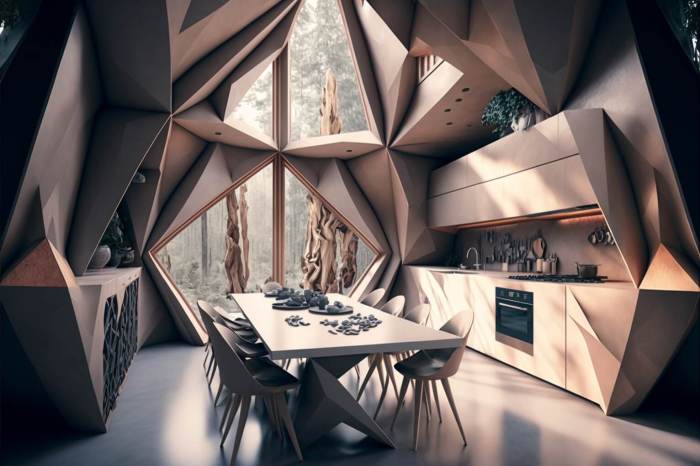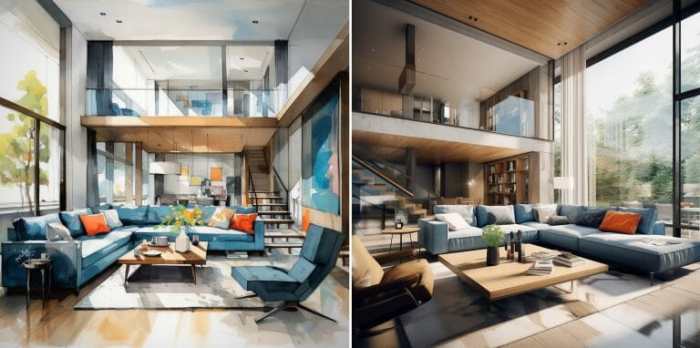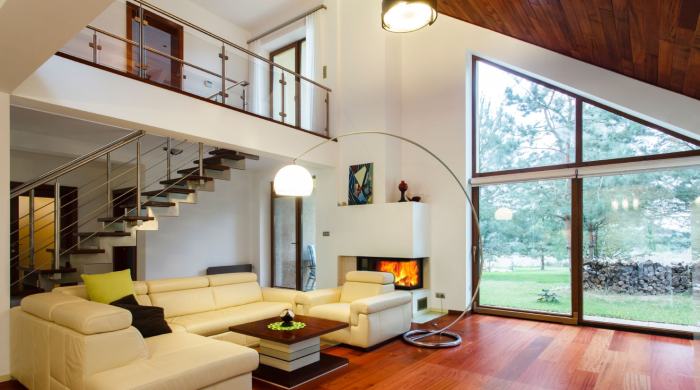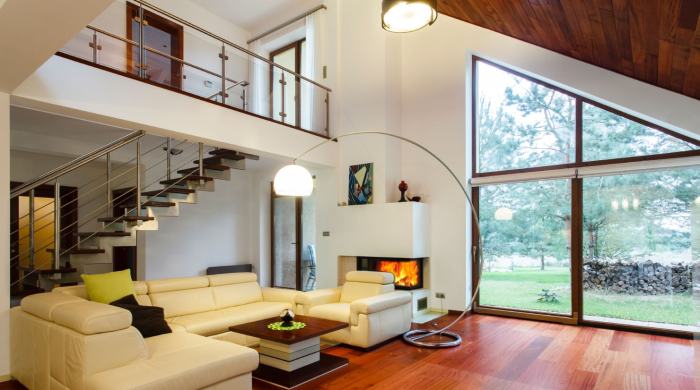AI house interior design is revolutionizing the way we think about our homes, merging technology and aesthetics to create spaces that are both beautiful and functional. Gone are the days of endless browsing through design magazines and scouring furniture stores for inspiration; AI-powered tools are now making it easier than ever to create personalized and intelligent home environments.
This emerging field leverages the power of artificial intelligence to analyze user preferences, design trends, and even smart home functionalities to generate tailored interior design solutions. From room planning and furniture selection to color scheme generation and smart home integration, AI is changing the game for homeowners and interior designers alike.
Case Studies of AI-Powered Interior Design Projects

AI-powered interior design is gaining traction, with several successful projects showcasing the potential of this technology. These projects demonstrate how AI can assist designers in creating innovative and personalized spaces, while also enhancing efficiency and reducing costs.
Examples of AI-Powered Interior Design Projects
This section explores a few prominent examples of AI-powered interior design projects, highlighting the specific AI tools and techniques used, and their impact on the design process and outcomes.
- Project 1: AI-Generated Apartment Design: This project involved the use of AI algorithms to generate multiple design layouts for an apartment based on user preferences and constraints. The AI tool analyzed user input, such as desired room sizes, furniture styles, and color palettes, to create a range of personalized design options.
The project demonstrated the ability of AI to quickly generate multiple design possibilities, allowing users to explore different layouts and styles before making a final decision.
- Project 2: AI-Assisted Furniture Selection: In this project, AI was used to assist designers in selecting furniture based on specific criteria. The AI tool analyzed a database of furniture pieces and their characteristics, such as size, style, and materials. By inputting the desired style, budget, and space constraints, the AI tool provided a curated list of furniture options that best met the design requirements.
AI house interior design is revolutionizing how we approach our homes, offering personalized and efficient solutions. One fascinating aspect is how AI can analyze and learn from existing styles, like the iconic 70s house interior design , and translate those elements into modern, functional spaces.
This ability to bridge the gap between nostalgia and innovation is what makes AI interior design so exciting, allowing us to create homes that are both timeless and cutting-edge.
This project highlighted the potential of AI to streamline the furniture selection process, reducing time and effort for designers.
- Project 3: AI-Powered Lighting Design: This project explored the use of AI to optimize lighting in interior spaces. The AI tool analyzed the geometry of a space, its intended use, and desired ambiance to create a lighting plan that met specific requirements. The AI tool considered factors such as natural light availability, desired light levels, and preferred color temperature to create a comfortable and functional lighting scheme.
AI house interior design is revolutionizing the way we approach home decor, offering personalized and efficient solutions. While AI can assist with various aspects, designing a large space like a 2500 sq ft house requires careful consideration. If you’re tackling a project of this scale, exploring resources like 2500 sq ft house interior design can provide valuable insights.
Ultimately, AI can be a powerful tool to complement your own design choices and create a truly unique and functional home.
This project showcased the ability of AI to enhance the functionality and aesthetics of interior spaces by optimizing lighting design.
Impact and Outcomes of AI-Driven Design Solutions, Ai house interior design
The implementation of AI in interior design projects has had a significant impact on the design process and outcomes.
- Increased Efficiency and Productivity: AI tools automate repetitive tasks, such as generating design layouts, selecting furniture, and optimizing lighting, allowing designers to focus on creative aspects of the design process. This increased efficiency leads to faster project completion times and higher productivity.
- Enhanced Personalization and Customization: AI algorithms analyze user preferences and constraints to create personalized design solutions. This enables designers to cater to individual needs and preferences, creating unique and satisfying spaces for clients. AI also allows for more flexibility and customization, enabling users to easily modify design elements and explore different options.
- Improved Cost-Effectiveness: AI tools can optimize resource utilization and reduce material waste, leading to cost savings in the design and construction phases. The ability of AI to generate multiple design options allows for more informed decision-making, reducing the risk of costly mistakes.
By automating tasks and streamlining the design process, AI contributes to a more cost-effective approach to interior design.
Design an AI-Powered Interior Design App: Ai House Interior Design

An AI-powered interior design app would revolutionize the way people approach home decor, making it accessible, personalized, and efficient. This app would leverage the power of artificial intelligence to provide users with a comprehensive design experience, from initial inspiration to final execution.
App Features and Functionalities
This app would offer a range of features designed to cater to the diverse needs of users.
- AI-Driven Design Recommendations: The app would analyze user preferences, such as style, color palettes, and furniture choices, to generate personalized design recommendations. It would also consider factors like room size, layout, and budget to provide practical and aesthetically pleasing suggestions.
- Virtual Room Planning: The app would allow users to create virtual representations of their rooms, using augmented reality or 3D modeling technology. This would enable users to experiment with different furniture arrangements, color schemes, and décor elements before making any real-world changes.
- Personalized Style Suggestions: The app would utilize machine learning algorithms to learn about users’ individual styles and preferences over time. It would then suggest curated selections of furniture, accessories, and artwork that align with their aesthetic tastes.
- Design Inspiration and Trend Exploration: The app would provide users with access to a vast library of interior design inspiration, including images, articles, and videos. It would also keep users updated on the latest trends in home décor and design.
- Shopping and Purchase Integration: The app would seamlessly integrate with online retailers and furniture stores, allowing users to purchase items directly from within the app. It would also provide price comparisons and product reviews to help users make informed decisions.
AI Enhancement of User Experience
The app would leverage AI to create a truly innovative and personalized design experience.
- Intelligent Design Assistant: The app would act as an intelligent design assistant, guiding users through the design process and providing expert advice. It would answer questions, offer solutions to design challenges, and suggest creative ideas.
- Style Recognition and Matching: The app would use computer vision to analyze images of users’ existing furniture, artwork, and home decor. It would then recommend complementary pieces and styles to create a cohesive and harmonious design aesthetic.
- Predictive Design Recommendations: The app would learn from user interactions and preferences to predict their future design needs. It would then proactively suggest relevant products, styles, and design solutions.
- Personalized Design Plans: The app would generate custom design plans based on user preferences, budget, and room specifications. These plans would include detailed drawings, material selections, and furniture placement suggestions.
End of Discussion

As AI continues to evolve, we can expect even more innovative and personalized interior design solutions. The future of our homes promises to be a seamless blend of style, functionality, and intelligent technology, all thanks to the transformative power of AI.
Whether you’re a seasoned homeowner or just starting to explore the world of interior design, AI is here to help you create a space that truly reflects your unique personality and lifestyle.
FAQ Compilation
What are some popular AI-powered interior design apps?
There are several popular AI-powered interior design apps available, such as Houzz, Roomstyler, and IKEA Place. These apps offer features like virtual room planning, furniture visualization, and style recommendations based on your preferences.
Is AI interior design expensive?
The cost of using AI for interior design varies depending on the specific tools and services you choose. Some apps offer free basic features, while others require subscriptions or one-time fees for premium features.
Can AI really understand my personal style?
AI algorithms are designed to learn from your input, such as images you save, design preferences you select, and even your location and lifestyle. By analyzing this data, AI can create personalized design recommendations that align with your taste.
